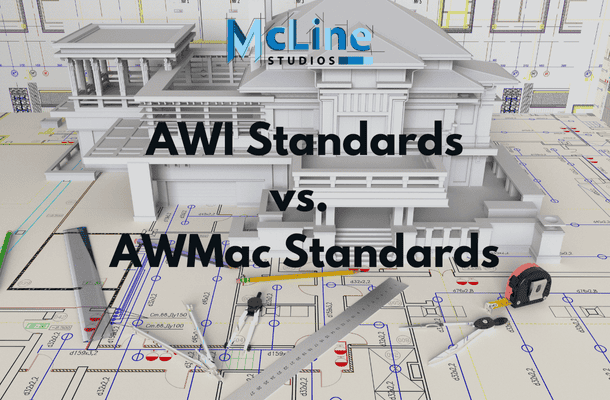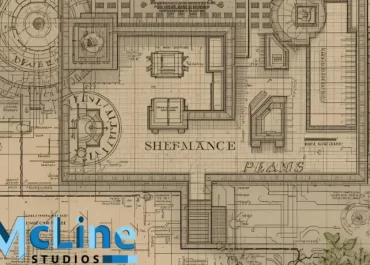In the millwork and woodworking industry, standards are essential for maintaining consistency, quality, and clear communication between designers, manufacturers, and installers. Two organizations stand out in North America when it comes to architectural woodwork standards: the Architectural Woodwork Institute (AWI) and the Architectural Woodwork Manufacturers Association of Canada (AWMAC).
While both support best practices in millwork production and installation, they follow different systems that reflect their regions and goals. Let’s take a closer look at how these standards differ and what that means for your next woodworking project.

What Are AWI Standards?
AWI standards are widely used in the U.S. and internationally. These standards cover design, material selection, construction methods, finishing, and installation practices for architectural woodwork like casework, millwork, and custom cabinetry.
The current AWI standards are written using the ANSI-approved process and are based on real-world testing and performance data. For example, casework standards not only define aesthetic grades (Premium, Custom, Economy) but also include Performance Duty Levels (1 through 4). These levels are backed by destructive lab testing, offering a measurable way to specify durability for different project requirements.
AWI standards lead with metric measurements, followed by imperial (U.S. customary) and decimal equivalents, making them more practical for global application, especially since only a few countries, including the U.S., still primarily use imperial units.
What Are AWMac Standards?
AWMac standards are guidelines set by the AWMac to maintain quality in millwork and woodworking projects. These standards outline the best practices for designing, manufacturing, and installing architectural woodwork like cabinets, paneling, moldings, and custom furniture.
AWMAC does not publish its own separate set of standards. Instead, it collaborates with the Woodwork Institute (based in California) to publish the North American Architectural Woodwork Standards (NAAWS).
NAAWS is widely used across Canada and by manufacturers in California. These standards are similar in scope to AWI’s but are often seen as more traditional in structure, using numeric designations for sections and covering best practices in materials, joinery, tolerances, and installation.
Like AWI, NAAWS also uses aesthetic grades and technical requirements for a wide range of millwork components. However, the performance-based framework in AWI’s newer standards is one of the key differences; AWI has moved toward quantifiable testing, whereas NAAWS remains more specification-driven.
Key Differences Between AWI and AWMAC/NAAWS Standards
Two of the most recognized standards in North America are those from AWI and AWMAC. While they aim for similar goals, ensuring quality and consistency, the way they go about it is quite different.
Let’s explore their differences in a straightforward way.
Who Publishes Them
- AWI Standards
Published by the Architectural Woodwork Institute, these standards are developed through an ANSI-accredited process, making them formal and widely accepted, especially in the U.S. Each topic, like casework, finishing, or wall panels, has its own individual standard rather than being part of one large manual.
- AWMAC/NAAWS Standards
AWMAC doesn’t publish its own independent standards. Instead, it works with the Woodwork Institute in the U.S. to maintain the North American Architectural Woodwork Standards (NAAWS). These are used throughout Canada and in parts of the U.S., especially California.
Measurement Systems
- AWI Standards
AWI puts metric units first, followed by imperial and decimals. This makes the standards more usable for international projects and reflects how much of the world already works in metric.
- AWMAC/NAAWS Standards
NAAWS uses a combination of metric and imperial, which fits Canada’s dual-measurement environment. However, switching between systems may take getting used to for some users.
Format and Usability
- AWI Standards
Newer AWI standards are easier to read. They’ve removed complicated number codes and replaced them with simple headings and clear layouts, which helps avoid errors during specification.
- AWMAC/NAAWS Standards
NAAWS still uses detailed numeric section codes, which work well for experienced users but can be more complex for new readers or those not familiar with the format.
Approach to Quality
- AWI Standards
AWI’s big advancement includes performance duty levels in some standards, especially for casework. These levels are backed by lab testing, showing exactly how strong or durable something is. This is helpful when you want to specify based on how a cabinet performs, not just how it looks.
- AWMAC/NAAWS Standards
NAAWS sticks to a specification-based approach, laying out detailed requirements for construction and materials. While solid and reliable, it doesn’t include lab-tested performance data like AWI does.
Where and How They’re Used
- AWI Standards
AWI has nearly 1,000 members globally, and while it’s U.S.-based, its standards are used internationally, especially on North American-designed projects built overseas.
- AWMAC/NAAWS Standards
AWMAC has about 400 members in Canada, and the NAAWS standard is widely accepted there. Some firms in both the U.S. and Canada are members of both AWI and AWMAC, giving them flexibility depending on the project.
Our Thoughts
Both AWI and AWMAC (NAAWS) standards aim to deliver quality architectural woodwork, but they do so in different ways.
- AWI stands out for its performance-driven standards, modern format, and international-friendly metric-first system.
- AWMAC/NAAWS is rooted in North American tradition, with a strong following in Canada and a clear, detailed specification model.
Choosing the right standard often comes down to where the project is located and what kind of documentation is required. For U.S. projects, especially those requiring ANSI compliance, AWI is the go-to. In Canada, NAAWS is often the preferred reference.
Special Thanks To Margaret Fisher, Communication Strategist at AWI




